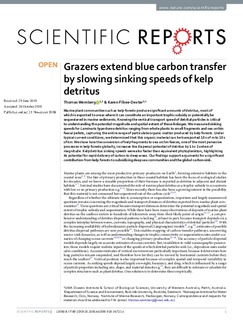| dc.contributor.author | Wernberg, Thomas | |
| dc.contributor.author | Filbee-Dexter, Karen | |
| dc.date.accessioned | 2019-01-07T09:59:47Z | |
| dc.date.available | 2019-01-07T09:59:47Z | |
| dc.date.created | 2018-12-11T15:30:30Z | |
| dc.date.issued | 2018 | |
| dc.identifier.citation | Scientific Reports. 2018, 8 (1), 1-7, 17180 . | nb_NO |
| dc.identifier.issn | 2045-2322 | |
| dc.identifier.uri | http://hdl.handle.net/11250/2579417 | |
| dc.description.abstract | Marine plant communities such as kelp forests produce significant amounts of detritus, most of which is exported to areas where it can constitute an important trophic subsidy or potentially be sequestered in marine sediments. Knowing the vertical transport speed of detrital particles is critical to understanding the potential magnitude and spatial extent of these linkages. We measured sinking speeds for Laminaria hyperborea detritus ranging from whole plants to small fragments and sea urchin faecal pellets, capturing the entire range of particulate organic matter produced by kelp forests. Under typical current conditions, we determined that this organic material can be transported 10 s of m to 10 s of km. We show how the conversion of kelp fragments to sea urchin faeces, one of the most pervasive processes in kelp forests globally, increases the dispersal potential of detritus by 1 to 2 orders of magnitude. Kelp detritus sinking speeds were also faster than equivalent phytoplankton, highlighting its potential for rapid delivery of carbon to deep areas. Our findings support arguments for a significant contribution from kelp forests to subsidizing deep sea communities and the global carbon sink. | nb_NO |
| dc.language.iso | eng | nb_NO |
| dc.publisher | Nature Research | nb_NO |
| dc.rights | Navngivelse 4.0 Internasjonal | * |
| dc.rights.uri | http://creativecommons.org/licenses/by/4.0/deed.no | * |
| dc.title | Grazers extend blue carbon transfer by slowing sinking speeds of kelp detritus | nb_NO |
| dc.type | Journal article | nb_NO |
| dc.type | Peer reviewed | nb_NO |
| dc.description.version | publishedVersion | nb_NO |
| dc.rights.holder | © The Author(s) 2018 | nb_NO |
| dc.source.pagenumber | 7 | nb_NO |
| dc.source.volume | 8 | nb_NO |
| dc.source.journal | Scientific Reports | nb_NO |
| dc.source.issue | 1 | nb_NO |
| dc.identifier.doi | 10.1038/s41598-018-34721-z | |
| dc.identifier.cristin | 1641813 | |
| dc.relation.project | Norges forskningsråd: 255085 | nb_NO |
| cristin.unitcode | 7464,20,11,0 | |
| cristin.unitname | Marin biologi | |
| cristin.ispublished | true | |
| cristin.fulltext | original | |
| cristin.qualitycode | 1 | |

